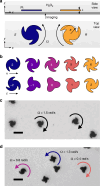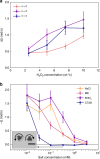Shape-directed rotation of homogeneous micromotors via catalytic self-electrophoresis
- PMID: 30700714
- PMCID: PMC6353883
- DOI: 10.1038/s41467-019-08423-7
Shape-directed rotation of homogeneous micromotors via catalytic self-electrophoresis
Abstract
The pursuit of chemically-powered colloidal machines requires individual components that perform different motions within a common environment. Such motions can be tailored by controlling the shape and/or composition of catalytic microparticles; however, the ability to design particle motions remains limited by incomplete understanding of the relevant propulsion mechanism(s). Here, we demonstrate that platinum microparticles move spontaneously in solutions of hydrogen peroxide and that their motions can be rationally designed by controlling particle shape. Nanofabricated particles with n-fold rotational symmetry rotate steadily with speed and direction specified by the type and extent of shape asymmetry. The observed relationships between particle shape and motion provide evidence for a self-electrophoretic propulsion mechanism, whereby anodic oxidation and cathodic reduction occur at different rates at different locations on the particle surface. We develop a mathematical model that explains how particle shape impacts the relevant electrocatalytic reactions and the resulting electrokinetic flows that drive particle motion.
Conflict of interest statement
The authors declare no competing interests.
Figures




Similar articles
-
Surface-Active Catalysts for Interfacial Gas-Liquid-Solid Reactions.Acc Mater Res. 2025 May 9;6(6):720-729. doi: 10.1021/accountsmr.5c00026. eCollection 2025 Jun 27. Acc Mater Res. 2025. PMID: 40611977 Free PMC article.
-
Sexual Harassment and Prevention Training.2024 Mar 29. In: StatPearls [Internet]. Treasure Island (FL): StatPearls Publishing; 2025 Jan–. 2024 Mar 29. In: StatPearls [Internet]. Treasure Island (FL): StatPearls Publishing; 2025 Jan–. PMID: 36508513 Free Books & Documents.
-
Short-Term Memory Impairment.2024 Jun 8. In: StatPearls [Internet]. Treasure Island (FL): StatPearls Publishing; 2025 Jan–. 2024 Jun 8. In: StatPearls [Internet]. Treasure Island (FL): StatPearls Publishing; 2025 Jan–. PMID: 31424720 Free Books & Documents.
-
Behavioral interventions to reduce risk for sexual transmission of HIV among men who have sex with men.Cochrane Database Syst Rev. 2008 Jul 16;(3):CD001230. doi: 10.1002/14651858.CD001230.pub2. Cochrane Database Syst Rev. 2008. PMID: 18646068
-
Factors that influence parents' and informal caregivers' views and practices regarding routine childhood vaccination: a qualitative evidence synthesis.Cochrane Database Syst Rev. 2021 Oct 27;10(10):CD013265. doi: 10.1002/14651858.CD013265.pub2. Cochrane Database Syst Rev. 2021. PMID: 34706066 Free PMC article.
Cited by
-
Accurate localization microscopy by intrinsic aberration calibration.Nat Commun. 2021 Jun 24;12(1):3925. doi: 10.1038/s41467-021-23419-y. Nat Commun. 2021. PMID: 34168121 Free PMC article.
-
Active Microrobots for Dual Removal of Biofilms via Chemical and Physical Mechanisms.ACS Appl Mater Interfaces. 2025 Jan 15;17(2):3608-3619. doi: 10.1021/acsami.4c18360. Epub 2025 Jan 2. ACS Appl Mater Interfaces. 2025. PMID: 39745814 Free PMC article.
-
Programming Tactic Behaviors of Active Colloids via Surface Charge.ACS Nano. 2025 Jun 17;19(23):21460-21467. doi: 10.1021/acsnano.5c02441. Epub 2025 Jun 7. ACS Nano. 2025. PMID: 40482062 Free PMC article.
-
Evolution of the Microrobots: Stimuli-Responsive Materials and Additive Manufacturing Technologies Turn Small Structures into Microscale Robots.Micromachines (Basel). 2024 Feb 15;15(2):275. doi: 10.3390/mi15020275. Micromachines (Basel). 2024. PMID: 38399003 Free PMC article. Review.
-
Reorientation behavior in the helical motility of light-responsive spiral droplets.Nat Commun. 2019 Nov 20;10(1):5238. doi: 10.1038/s41467-019-13201-6. Nat Commun. 2019. PMID: 31748502 Free PMC article.
References
-
- Paxton, W. F. et al. Catalytic nanomotors: autonomous movement of striped nanorods. J. Am. Chem. Soc.126, 13424–13431 (2004). - PubMed
-
- Han, K., Shields, C. W. & Velev, O. D. Engineering of self-propelling microbots and microdevices powered by magnetic and electric fields. Adv. Funct. Mater. 28, 1705953 (2018).
-
- Palagi, S. & Fischer, P. Bioinspired microrobots. Nat. Rev. Mater.3, 113–124 (2018).
-
- Bechinger, C. et al. Active particles in complex and crowded environments. Rev. Mod. Phys.88, 045006 (2016).
-
- Illien, P., Golestanian, R. & Sen, A. ‘Fuelled’ motion: phoretic motility and collective behaviour of active colloids. Chem. Soc. Rev.46, 5508–5518 (2017). - PubMed
Publication types
LinkOut - more resources
Full Text Sources

